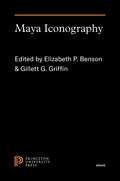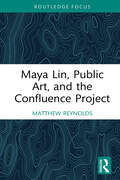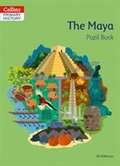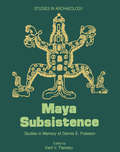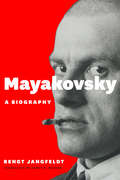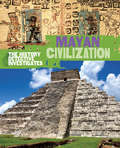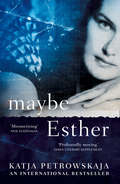- Table View
- List View
Maya Daykeeping: Three Calendars from Highland Guatemala (Mesoamerican Worlds)
by Christian M. Prager Frauke Sachse John M. WeeksIn Maya Daykeeping, three divinatory calendars from highland Guatemala - examples of a Mayan literary tradition that includes the Popul Vuh, Annals of the Cakchiquels, and the Titles of the Lords of Totonicapan - dating to 1685, 1722, and 1855, are transcribed in K'iche or Kaqchikel side-by-side with English translations. Calendars such as these continue to be the basis for prognostication, determining everything from the time for planting and harvest to foreshadowing illness and death. Good, bad, and mixed fates can all be found in these examples of the solar calendar and the 260-day divinatory calendar. The use of such calendars is mentioned in historical and ethnographic works, but very few examples are known to exist. Each of the three calendars transcribed and translated by John M. Weeks, Frauke Sachse, and Christian M. Prager - and housed at the University of Pennsylvania Museum of Archaeology and Anthropology - is unique in structure and content. Moreover, except for an unpublished study of the 1722 calendar by Rudolf Schuller and Oliver La Farge (1934), these little-known works appear to have escaped the attention of most scholars. Introductory essays contextualize each document in time and space, and a series of appendixes present previously unpublished calendrical notes assembled in the early twentieth century. Providing considerable information on the divinatory use of calendars in colonial highland Maya society previously unavailable without a visit to the University of Pennsylvania's archives, Maya Daykeeping is an invaluable primary resource for Maya scholars. Mesoamerican Worlds Series
Maya Iconography
by Elizabeth P. Benson Gillett G. GriffinA landmark work on the iconography of one of the world&’s great civilizationsThis book presents foundational work on Maya iconography from leading practitioners in fields ranging from archaeology, anthropology, and art history to linguistics, astronomy, photography, and medicine. The period discussed runs from the last centuries B.C. through the great Maya Classic period, with some discussion of later eras and of regions outside the Maya area. Featuring an incisive introduction by Elizabeth Benson and Gillett Griffin, Maya Iconography demonstrates how Maya beliefs developed over time and makes important connections between Preclassic and Classic iconography.The contributors are John Carlson, Michael Coe, David Freidel, Donald Hales, Norman Hammond, Nicholas Hellmuth, John Justeson, Barbara Kerr, Justin Kerr, Mary Ellen Miller, William Norman, Lee Parsons, Francis Robicsek, Linda Schele, David Stuart, and Karl Taube.
Maya Iconography
by Elizabeth P. Benson Gillett G. GriffinA landmark work on the iconography of one of the world&’s great civilizationsThis book presents foundational work on Maya iconography from leading practitioners in fields ranging from archaeology, anthropology, and art history to linguistics, astronomy, photography, and medicine. The period discussed runs from the last centuries B.C. through the great Maya Classic period, with some discussion of later eras and of regions outside the Maya area. Featuring an incisive introduction by Elizabeth Benson and Gillett Griffin, Maya Iconography demonstrates how Maya beliefs developed over time and makes important connections between Preclassic and Classic iconography.The contributors are John Carlson, Michael Coe, David Freidel, Donald Hales, Norman Hammond, Nicholas Hellmuth, John Justeson, Barbara Kerr, Justin Kerr, Mary Ellen Miller, William Norman, Lee Parsons, Francis Robicsek, Linda Schele, David Stuart, and Karl Taube.
Maya Lin, Public Art, and the Confluence Project (Routledge Focus on Art History and Visual Studies)
by Matthew ReynoldsThe first scholarly monograph devoted exclusively to this vital work of contemporary public art, this book examines Maya Lin’s Confluence Project through the lens of environmental humanities and Indigenous studies. Matthew Reynolds provides a detailed analysis of each earthwork, along with a discussion of the proposed final project at Celilo Falls near The Dalles, Oregon. The book assesses the artist’s longtime engagement with the region of the Pacific Northwest and explores the Confluence Project within Lin’s larger oeuvre. Several consistent themes and experiences are common amongst all the sites. These include an emphasis on individual, multisensory encounters with the earthworks and their surrounding contexts; sound as an experiential dimension of landscape; indexical accounts of the multicultural, multispecies histories of each place; and an evocation of loss. The book will be of interest to scholars working in art history, contemporary art, environmental studies, environmental humanities, and Native American studies.
Maya Lin, Public Art, and the Confluence Project (Routledge Focus on Art History and Visual Studies)
by Matthew ReynoldsThe first scholarly monograph devoted exclusively to this vital work of contemporary public art, this book examines Maya Lin’s Confluence Project through the lens of environmental humanities and Indigenous studies. Matthew Reynolds provides a detailed analysis of each earthwork, along with a discussion of the proposed final project at Celilo Falls near The Dalles, Oregon. The book assesses the artist’s longtime engagement with the region of the Pacific Northwest and explores the Confluence Project within Lin’s larger oeuvre. Several consistent themes and experiences are common amongst all the sites. These include an emphasis on individual, multisensory encounters with the earthworks and their surrounding contexts; sound as an experiential dimension of landscape; indexical accounts of the multicultural, multispecies histories of each place; and an evocation of loss. The book will be of interest to scholars working in art history, contemporary art, environmental studies, environmental humanities, and Native American studies.
The Maya Pupil Book (Collins Primary History Ser.)
by Alf WilkinsonCollins Primary History provides a rich coverage of the Primary National Curriculum for History. Packed with information, source materials, questions and activities, the beautifully designed pupil books support children to explore, interpret and develop knowledge of significant historical periods. The accompanying Teacher's Guide provides planning support and guidance on making progress in history.
Maya Revolt and Revolution in the Eighteenth Century
by Robert W. PatchRecords of revolts, rebellions, and revolutions provide insight into the nature of the Maya in the colonial period. This book presents five case studies - four in Guatemala and one in Yucatan, Mexico - of eighteenth-century Maya acts of violent resistance to colonialism, and, in the process, reveals a great deal about indigenous culture, social structure, politics, economics, lineage, and gender. The author carefully analyzes the causes of, participation in, and resolution of each uprising, explaining the different political, economic, and cultural catalysts, and the scope and outcome of each conflict. Through such detailed narratives, the reader not only learns about the reality of colonialism but also encounters the flesh-and-blood, real-life individuals and groups who resisted, counteracted, circumvented, and defied the Spaniards. These stories reveal the drama, tragedy, and even comedy of the history of ordinary people and everyday life at the time.
Maya Revolt and Revolution in the Eighteenth Century (Latin American Realities Ser.)
by Robert W. PatchRecords of revolts, rebellions, and revolutions provide insight into the nature of the Maya in the colonial period. This book presents five case studies - four in Guatemala and one in Yucatan, Mexico - of eighteenth-century Maya acts of violent resistance to colonialism, and, in the process, reveals a great deal about indigenous culture, social structure, politics, economics, lineage, and gender. The author carefully analyzes the causes of, participation in, and resolution of each uprising, explaining the different political, economic, and cultural catalysts, and the scope and outcome of each conflict. Through such detailed narratives, the reader not only learns about the reality of colonialism but also encounters the flesh-and-blood, real-life individuals and groups who resisted, counteracted, circumvented, and defied the Spaniards. These stories reveal the drama, tragedy, and even comedy of the history of ordinary people and everyday life at the time.
Maya Society under Colonial Rule: The Collective Enterprise of Survival
by Nancy Marguerite FarrissThis book traces the history of the Maya Indians of Yucatan, Mexico,during a four-hundred-year period from late preconquest times throughthe end of Spanish rule in 1821. Nancy Farriss combines the tools of thehistorian and the anthropologist to reconstruct colonial Maya society andculture as a web of interlocking systems, from ecology and modes ofsubsistence through the corporate family and the community to the realmof the sacred. She shows how the Maya adapted to Spanish domination,changing in ways that embodied Maya principles as they applied theirtraditional collective strategies for survival to the new challenges; they fared better under colonial rule than the Aztecs or Incas, who lived in areas more economically attractive to the conquering Spaniards. The author draws on archives and private collections in Seville, Mexico City, and Yucatan; on linguistic evidence from native language documents; and on archaeological and ethnographic data from sources that include her own fieldwork. Her innovative book illuminates not only Maya history and culture but also the nature and functioning of premodern agrarian societies in general and their processes of sociocultural change, especially under colonial rule.
Maya Worldviews at Conquest (Mesoamerican Worlds)
by Leslie G. Cecil Timothy W. PughMaya Worldviews at Conquest examines Maya culture and social life just prior to contact and the effect the subsequent Spanish conquest, as well as contact with other Mesoamerican cultures, had on the Maya worldview. Focusing on the Postclassic and Colonial periods, Maya Worldviews at Conquest provides a regional investigation of archaeological and epigraphic evidence of Maya ideology, landscape, historical consciousness, ritual practices, and religious symbolism before and during the Spanish conquest. Through careful investigation, the volume focuses on the impact of conversion, hybridization, resistance, and revitalization on the Mayans’ understanding of their world and their place in it. The volume also addresses the issue of anthropologists unconsciously projecting their modern worldviews on the culture under investigation. Thus, the book critically defines and strengthens the use of worldviews in the scholarly literature regardless of the culture studied, making it of value not only to Maya scholars but also to those interested in the anthropologist’s projection of worldview on other cultures in general.
Mayakovsky: A Biography
by Bengt JangfeldtFew poets have led lives as tempestuous as that of Vladimir Mayakovsky. Born in 1893 and dead by his own hand in 1930, Mayakovsky packed his thirty-six years with drama, politics, passion, and—most important—poetry. An enthusiastic supporter of the Russian Revolution and the emerging Soviet State, Mayakovsky was championed by Stalin after his death and enshrined as a quasi-official Soviet poet, a position that led to undeserved neglect among Western literary scholars even as his influence on other poets has remained powerful. With Mayakovsky, Bengt Jangfeldt offers the first comprehensive biography of Mayakovsky, revealing a troubled man who was more dreamer than revolutionary, more political romantic than hardened Communist. Jangfeldt sets Mayakovsky’s life and works against the dramatic turbulence of his times, from the aesthetic innovations of the pre-revolutionary avant-garde to the rigidity of Socialist Realism and the destruction of World War I to the violence—and hope—of the Russian Revolution, through the tightening grip of Stalinist terror and the growing disillusion with Russian communism that eventually led the poet to take his life. Through it all is threaded Mayakovsky’s celebrated love affair with Lili Brik and the moving relationship with Lili’s husband, Osip, along with a brilliant depiction of the larger circle of writers and artists around Mayakovsky, including Maxim Gorky, Viktor Shklovsky, Alexander Rodchenko, and Roman Jakobson. The result is a literary life viewed in the round, enabling us to understand the personal and historical furies that drove Mayakovsky and generated his still-startling poetry. Illustrated throughout with rare images of key characters and locations, Mayakovsky is a major step in the revitalization of a crucial figure of the twentieth-century avant-garde.
Mayakovsky: A Biography
by Bengt JangfeldtFew poets have led lives as tempestuous as that of Vladimir Mayakovsky. Born in 1893 and dead by his own hand in 1930, Mayakovsky packed his thirty-six years with drama, politics, passion, and—most important—poetry. An enthusiastic supporter of the Russian Revolution and the emerging Soviet State, Mayakovsky was championed by Stalin after his death and enshrined as a quasi-official Soviet poet, a position that led to undeserved neglect among Western literary scholars even as his influence on other poets has remained powerful. With Mayakovsky, Bengt Jangfeldt offers the first comprehensive biography of Mayakovsky, revealing a troubled man who was more dreamer than revolutionary, more political romantic than hardened Communist. Jangfeldt sets Mayakovsky’s life and works against the dramatic turbulence of his times, from the aesthetic innovations of the pre-revolutionary avant-garde to the rigidity of Socialist Realism and the destruction of World War I to the violence—and hope—of the Russian Revolution, through the tightening grip of Stalinist terror and the growing disillusion with Russian communism that eventually led the poet to take his life. Through it all is threaded Mayakovsky’s celebrated love affair with Lili Brik and the moving relationship with Lili’s husband, Osip, along with a brilliant depiction of the larger circle of writers and artists around Mayakovsky, including Maxim Gorky, Viktor Shklovsky, Alexander Rodchenko, and Roman Jakobson. The result is a literary life viewed in the round, enabling us to understand the personal and historical furies that drove Mayakovsky and generated his still-startling poetry. Illustrated throughout with rare images of key characters and locations, Mayakovsky is a major step in the revitalization of a crucial figure of the twentieth-century avant-garde.
Mayakovsky: A Biography
by Bengt JangfeldtFew poets have led lives as tempestuous as that of Vladimir Mayakovsky. Born in 1893 and dead by his own hand in 1930, Mayakovsky packed his thirty-six years with drama, politics, passion, and—most important—poetry. An enthusiastic supporter of the Russian Revolution and the emerging Soviet State, Mayakovsky was championed by Stalin after his death and enshrined as a quasi-official Soviet poet, a position that led to undeserved neglect among Western literary scholars even as his influence on other poets has remained powerful. With Mayakovsky, Bengt Jangfeldt offers the first comprehensive biography of Mayakovsky, revealing a troubled man who was more dreamer than revolutionary, more political romantic than hardened Communist. Jangfeldt sets Mayakovsky’s life and works against the dramatic turbulence of his times, from the aesthetic innovations of the pre-revolutionary avant-garde to the rigidity of Socialist Realism and the destruction of World War I to the violence—and hope—of the Russian Revolution, through the tightening grip of Stalinist terror and the growing disillusion with Russian communism that eventually led the poet to take his life. Through it all is threaded Mayakovsky’s celebrated love affair with Lili Brik and the moving relationship with Lili’s husband, Osip, along with a brilliant depiction of the larger circle of writers and artists around Mayakovsky, including Maxim Gorky, Viktor Shklovsky, Alexander Rodchenko, and Roman Jakobson. The result is a literary life viewed in the round, enabling us to understand the personal and historical furies that drove Mayakovsky and generated his still-startling poetry. Illustrated throughout with rare images of key characters and locations, Mayakovsky is a major step in the revitalization of a crucial figure of the twentieth-century avant-garde.
Mayakovsky: A Biography
by Bengt JangfeldtFew poets have led lives as tempestuous as that of Vladimir Mayakovsky. Born in 1893 and dead by his own hand in 1930, Mayakovsky packed his thirty-six years with drama, politics, passion, and—most important—poetry. An enthusiastic supporter of the Russian Revolution and the emerging Soviet State, Mayakovsky was championed by Stalin after his death and enshrined as a quasi-official Soviet poet, a position that led to undeserved neglect among Western literary scholars even as his influence on other poets has remained powerful. With Mayakovsky, Bengt Jangfeldt offers the first comprehensive biography of Mayakovsky, revealing a troubled man who was more dreamer than revolutionary, more political romantic than hardened Communist. Jangfeldt sets Mayakovsky’s life and works against the dramatic turbulence of his times, from the aesthetic innovations of the pre-revolutionary avant-garde to the rigidity of Socialist Realism and the destruction of World War I to the violence—and hope—of the Russian Revolution, through the tightening grip of Stalinist terror and the growing disillusion with Russian communism that eventually led the poet to take his life. Through it all is threaded Mayakovsky’s celebrated love affair with Lili Brik and the moving relationship with Lili’s husband, Osip, along with a brilliant depiction of the larger circle of writers and artists around Mayakovsky, including Maxim Gorky, Viktor Shklovsky, Alexander Rodchenko, and Roman Jakobson. The result is a literary life viewed in the round, enabling us to understand the personal and historical furies that drove Mayakovsky and generated his still-startling poetry. Illustrated throughout with rare images of key characters and locations, Mayakovsky is a major step in the revitalization of a crucial figure of the twentieth-century avant-garde.
Mayan Civilization (The History Detective Investigates #35)
by Clare HibbertWho were the Maya? Why did the Maya build temples? What was Mayan writing like? How did the Maya dress? This book helps children at Key Stage 2 discover the answers to these and other fascinating questions. It also recommends sites on the Internet and sources in your local library where you can find out more about Mayan civilisation. The detective shows readers how to make a pictorial timeline of important Mayan kings, construct your own model pyramid, based on a real Mayan one and find ways to make delicious Mayan meals. Packed with fascinating information, The History Detective Investigates series inspires children's curiosity to find out more about the past. A great tool for readers age 8+ or teachers looking for books to support the new curriculum for 2014.
The Mayan Codex (The Antichrist Series #2)
by Mario ReadingAdam Sabir has discovered the missing quatrains of Nostradamus, and the events they foretell are coming true. But there's one prophecy he can't fully decipher, and it warns of the imminent arrival of the Third Antichrist. Sabir's every move is the Corpus Maleficus, an ancient cabal devoted to serving the Antichrist. Disfigured, orphaned, groomed for cruelty and violence, they are prepared to do anything to stop him. As Sabir puzzles over the riddle, a descendant of the Mayans embarks on a dangerous journey. He must deliver a sacred codex to the Palace of the Masks. Only then can the secret of Nostradamus' prophecy be revealed...
Maybe Esther: A Family Story
by Katja PetrowskajaThe poignant, searching, haunting story of one family’s entanglement with twentieth-century history AN INTERNATIONAL BESTSELLER
Mayday! Mayday!: The History Of Sea Rescue Around Britain's Coastal Waters
by Karen Farrington Nick ConstableLifeboats occupy a particular place in people’s hearts as unpaid volunteers regularly take to their boats often in extremely adverse conditions to rescue others from the sea.
The Mayfair Mystery: 2835 Mayfair (Detective Club Crime Classics)
by Frank RichardsonThe first in a new series of classic detective stories from the vaults of HarperCollins involves a disappearing corpse, a supernatural theory, and a genuinely shocking finale.
Mayfield: An epic saga of love, loss and sacrifice
by Joy ChambersThe overwhelming and consuming love of two men for the same indomitable woman...Mayfield is Joy Chambers' gripping saga set across nineteenth-century Australia and all the way to Boston, USA. The perfect read for fans of Judith Kinghorn and Patricia Shaw.'Written with an ease of style and sophistication' - Liverpool Echo In the grandest wedding the small western plains town of Bathurst has ever seen, Eve Herman, without position or money, is marrying John Stuart Wakeman, one of the richest, most influential men in the land. Before their wedding day is over, Australia's most wanted man, the bushranger Alan Fletcher, will have held up their coach and altered all their lives... Alan Fletcher: aristocrat and Royal Naval Captain, wrongly convicted of murder and transported to New South Wales for life. Eve Herman: American orphan, abandoned in Sydney town and left to survive by her wits and courage. John Stuart Wakeman: the owner of fabled Mayfield, Australia's largest and most prosperous cattle property. Mayfield is their story: from the streets of Southampton to the vast bush country of New South Wales and across the world to the city of old Boston, USA.What people are saying about Mayfield:'Very enlightening historical facts add to the depth of the story. Highly recommended' 'Totally absorbing''If you love family sagas then this book is for you'
Mayflower: The Voyage that Changed the World
by Christopher HiltonThe band of Puritan emigres that left Southampton in 1620 to found a godly colony in Virginia (as the eastern seaboard of the North American continent was known then) carried with them the ideological seed-corn of a new nation. This is the story of their voyage, their settlement in New England and the influence they had on the forging of a nation

